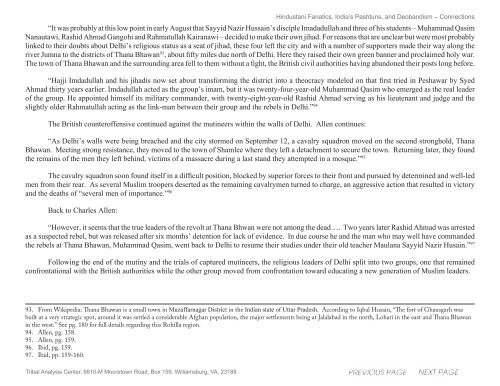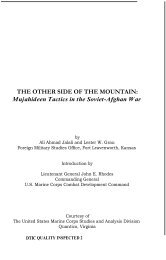Hindustani Fanatics, India’s Pashtuns, <strong>and</strong> Deob<strong>and</strong>ism – ConnectionsDeob<strong>and</strong>i origins: A Highly Probable Connection to the Rohillas“It will be remembered that after the martyrdom of Syed Ahmad at Balakot divisions had opened up between the Wahhabi ‘Patna-ites’ led by WilayatAli <strong>and</strong> the Wahhabi ‘Delhi-ites’. For many years the latter were led by Shah Waliullah’s gr<strong>and</strong>son, Shah Muhammad Ishaq, whose cousin <strong>and</strong> brother-inlawwere Syed Ahmad’s first two disciples. Following the death of his cousin with Syed Ahmad in 1831, Shah Muhammad Ishaq <strong>and</strong> a group of his discipleshad migrated to Arabia. After an absence of many years he <strong>and</strong> his followers returned to Delhi, where Shah Muhammad Ishaq placed himself at the head ofa radical circle of scholars working within the traditions established by his gr<strong>and</strong>father. After Shah Muhammad Ishaq’s death in 1846 the Madrassah-i-Rahimiya broke up into a number of interlinked schools, of which the most obviously Wahhabi was that led by Maulana Sayyid Nazir Hussain of Delhi.“Born in 1805 Sayyid Nazir Hussain had begun his religious studies in Patna at the Sadiqpore house of one of the heads of the three Patnafamilies, Muhammad Hussain, <strong>and</strong> it was there that he first heard Syed Ahmed speak in the 1820s. He later moved up to Delhi to sit at the feet firstof Shah Abdul Aziz <strong>and</strong> then of his son <strong>and</strong> successor, Shah Muhammad Ishaq, becoming in time a highly respected teacher of Hadith. The degree towhich Sayyid Nazir Hussain participated in the 1857 Mutiny can only be guessed at.“The undisputed facts are that on 19 May 1857, eight days after the arrival of the mutineers from Meerut 91 , a group of mullahs erected agreen banner on the roof of the city’s greatest mosque, the Jama Masjid <strong>and</strong> published a fatwa proclaiming jihad. As soon as he heard of it, theEmperor ordered the banner to be removed <strong>and</strong> denounced the jihad fatwa as great folly because it would alienate his Hindu supporters. His actionswere supported by the Wahhabi ‘Delhi-ites’, but for very different reasons. Sayyid Nazir Hussain is said to have considered this declaration ofjihad to be ‘faithlessness, breach of convenant <strong>and</strong> mischief’, <strong>and</strong> to have pronounced that it was a sin to take part in it. But his reasons for doingso were essentially doctrinal: he <strong>and</strong> other Sunni fundamentalists viewed the emperor as ‘little better than a heretic’ on account of his insistenceon working with Shias <strong>and</strong> Hindus; <strong>and</strong> he did not consider Delhi to be a Dar-ul-Islam, making it unlawful to proclaim jihad from there. All theevidence suggests that the ‘Delhi-ites’ <strong>and</strong> other Sunni hard-liners in the city initially remained aloof from the mutineers <strong>and</strong> kept their own counsel.“However, everything changed with the arrival in Delhi on 2 July of a large contingent of sepoys accompanied by ‘three or four thous<strong>and</strong> ghazis[warriors of the faith but, in British eyes, <strong>fanatics</strong>]’. A significant number of these ghazis, led by one Maulvi Sarfaraz Alu, were Wahhabis. They hadcome from the town of Bareilly (not to be confused with Syed Ahmad’s birthplace in Oude, Rae Bareli), capital of Rohilk<strong>and</strong>, which in earlier dayshad been an Afghan-Pathan stronghold in the plains. Ever since Syed Ahmad’s day Bareilly had been an outpost of Wahhabism on a par with thatother Pathan bastion, Tonk.” 92As the Delhi mutineers began to split, there were some among them who decided to leave the city to create their own Dar-ul-Islam, an abodeof faith from which jihad could be proclaimed. Two of Nazir Hussain’s disciples leaving Delhi were Muhammad Qasim <strong>and</strong> Rashid Ahmad, keyleaders soon to become even more significant in the political-religious aspects of India.Charles Allen’s excellent work continued to explain this phase of the Mutiny:91. Meerut is located in Uttar Predesh, the region formerly controlled by Rohillas.92. Allen, pg. 137.Tribal Analysis Center, 6610-M Mooretown Road, Box 159. Williamsburg, VA, 23188
Hindustani Fanatics, India’s Pashtuns, <strong>and</strong> Deob<strong>and</strong>ism – Connections“It was probably at this low point in early August that Sayyid Nazir Hussain’s disciple Imadadullah <strong>and</strong> three of his students – Muhammad QasimNanautawi, Rashid Ahmad Gangohi <strong>and</strong> Rahmatullah Kairanawi – decided to make their own jihad. For reasons that are unclear but were most probablylinked to their doubts about Delhi’s religious status as a seat of jihad, these four left the city <strong>and</strong> with a number of supporters made their way along theriver Jumna to the districts of Thana Bhawan 93 , about fifty miles due north of Delhi. Here they raised their own green banner <strong>and</strong> proclaimed holy war.The town of Thana Bhawan <strong>and</strong> the surrounding area fell to them without a fight, the British civil authorities having ab<strong>and</strong>oned their posts long before.“Hajji Imdadullah <strong>and</strong> his jihadis now set about transforming the district into a theocracy modeled on that first tried in Peshawar by SyedAhmad thirty years earlier. Imdadullah acted as the group’s imam, but it was twenty-four-year-old Muhammad Qasim who emerged as the real leaderof the group. He appointed himself its military comm<strong>and</strong>er, with twenty-eight-year-old Rashid Ahmad serving as his lieutenant <strong>and</strong> judge <strong>and</strong> theslightly older Rahmatullah acting as the link-man between their group <strong>and</strong> the rebels in Delhi.” 94The British counteroffensive continued against the mutineers within the walls of Delhi. Allen continues:“As Delhi’s walls were being breached <strong>and</strong> the city stormed on September 12, a cavalry squadron moved on the second stronghold, ThanaBhawan. Meeting strong resistance, they moved to the town of Shamlee where they left a detachment to secure the town. Returning later, they foundthe remains of the men they left behind, victims of a massacre during a last st<strong>and</strong> they attempted in a mosque.” 95The cavalry squadron soon found itself in a difficult position, blocked by superior forces to their front <strong>and</strong> pursued by determined <strong>and</strong> well-ledmen from their rear. As several Muslim troopers deserted as the remaining cavalrymen turned to charge, an aggressive action that resulted in victory<strong>and</strong> the deaths of “several men of importance.” 96Back to Charles Allen:“However, it seems that the true leaders of the revolt at Thana Bhwan were not among the dead…. Two years later Rashid Ahmad was arrestedas a suspected rebel, but was released after six months’ detention for lack of evidence. In due course he <strong>and</strong> the man who may well have comm<strong>and</strong>edthe rebels at Thana Bhawan, Muhammad Qasim, went back to Delhi to resume their studies under their old teacher Maulana Sayyid Nazir Husain.” 97Following the end of the mutiny <strong>and</strong> the trials of captured mutineers, the religious leaders of Delhi split into two groups, one that remainedconfrontational with the British authorities while the other group moved from confrontation toward educating a new generation of Muslim leaders.93. From Wikipedia: Thana Bhawan is a small town in Muzaffarnagar District in the Indian state of Uttar Pradesh. According to Iqbal Husain, “The fort of Ghausgarh wasbuilt at a very strategic spot, around it was settled a considerable Afghan population, the major settlements being at Jalalabad in the north, Lohari in the east <strong>and</strong> Thana Bhawanin the west.” See pg. 180 for full details regarding this Rohilla region.94. Allen, pg. 158.95. Allen, pg. 159.96. Ibid, pg. 159.97. Ibid, pp. 159-160.Tribal Analysis Center, 6610-M Mooretown Road, Box 159. Williamsburg, VA, 23188
- Page 7 and 8: Hindustani Fanatics, India’s Pash
- Page 9 and 10: Hindustani Fanatics, India’s Pash
- Page 11 and 12: Hindustani Fanatics, India’s Pash
- Page 13 and 14: Hindustani Fanatics, India’s Pash
- Page 15 and 16: And Charles Allen described the sce
- Page 17 and 18: Hindustani Fanatics, India’s Pash
- Page 19 and 20: Charles Allen provided additional d
- Page 21 and 22: Hindustani Fanatics, India’s Pash
- Page 23 and 24: Hindustani Fanatics, India’s Pash
- Page 25: Hindustani Fanatics, India’s Pash
- Page 29 and 30: that Shah Waliullah’s ancestors w
- Page 32: Hindustani Fanatics, India’s Pash
- Page 35 and 36: Hindustani Fanatics, India’s Pash
- Page 37 and 38: Hindustani Fanatics, India’s Pash
- Page 39: Hindustani Fanatics, India’s Pash
- Page 42 and 43: Hindustani Fanatics, India’s Pash
- Page 44 and 45: Hindustani Fanatics, India’s Pash
- Page 46 and 47: Hindustani Fanatics, India’s Pash
- Page 48 and 49: Hindustani Fanatics, India’s Pash
- Page 50 and 51: Hindustani Fanatics, India’s Pash
- Page 52 and 53: Hindustani Fanatics, India’s Pash
- Page 54 and 55: Hindustani Fanatics, India’s Pash
















